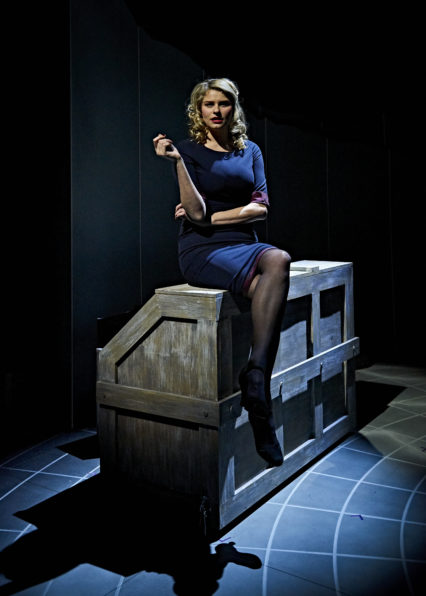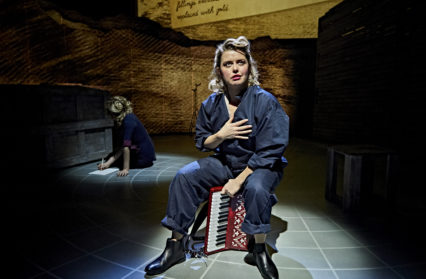Marine Furet was at the Wales Millennium Centre in Cardiff to review The Beauty Parade, the latest play from pioneering theatre-maker Kaite O’Reilly.
The Beauty Parade begins first and foremost with the story of a serendipitous meeting between the writer and director Kaite O’Reilly and heroine Molly Schuesselle, who acted as a codebreaker during the Second World War. Sworn to silence by the Official Secrets Act, Schuesselle found a receptive ear in O’Reilly, who now brings this story of danger and bravery to the stage with co-director Phillip Zarrilli. The production is an undeniable achievement, a moving piece characterised by O’Reilly’s distinctive attention to questions of accessibility and deafness.

Performed by three actresses, Anne-Marie Piazza, Georgina White, and Sophie Stone, The Beauty Parade tells the story of hundreds of women who were trained and sent behind enemy lines in occupied France during World War II. Bilingual and trained in spying, intelligence, and close combat, those sent to the field would survive six weeks on average – one week less than the time spent preparing them before the start of their mission. Lillian (Anne-Marie Piazza) is a ‘pianist’, trained to send radio transmissions of intel gathered by Resistance Spies. Madeleine (Georgina White) plays the ‘femme fatale’, charged with seducing German officers into disclosing classified secrets. Deaf actress Sophie Stone plays the part of their training instructor, herself a former Beauty Parade agent retired from the field.
To tell this compelling tale of The Beauty Parade, O’Reilly, Stone, and musical director Rebecca Applin have devised a blend of spoken word, physical language, and music. The final result is so seamless as to erase the assiduous labour that must have gone on behind the scenes to put this brilliant narrative together. As Lillian and Madeleine sing and speak their stories, Stone, standing on a platform above the stage, translates it into visual language. The whole show is also captioned, with a video background artfully designed by Ash Woodward that brings the atmosphere of war on stage, complete with the BBC radio transmissions and its poetically coded signals sent to France through ‘L’Appel de Londres’ during the German Occupation. The resulting process enhances rather than detracts from the onstage action, and seeing work of the quality of O’Reilly’s can only raise questions as to why more directors do not follow in her steps to bring theatre to a more diverse audience and to enhance the role of disabled performers.
Piazza, Stone, and White are splendid actresses, who offer a nuanced rendition of these women’s difficult accession to an eminently masculine realm in The Beauty Parade. White’s Madeleine treads a delicate balance of 1940s glamour and bitterness in her role as an undercover agent, perceived by the population as a collaborator involved in ‘horizontal manoeuvres’ with the enemy. As she reminds us, those women convicted of betrayal for having had liaisons with German soldiers were often left to be publicly shamed or chastised by the crowd after the war. Lillian brings fresh-faced naivety to the operation and is shown growing into her role as she comes to understand the risks involved in her mission. A woman brought to play a part greater and infinitely more perilous than the one she had initially envisaged for herself, Lillian is often the spectator’s point of entry into the story, a role Piazza takes on with straightforwardness and elegance. Finally, Stone carries the weight of her character’s remorse at sending her trainees to certain death with suitable gravitas and pathos and is given some of the play’s most memorable monologues in both spoken and physical language.
In The Beauty Parade, all three characters let out their bitterness at being women of action forced to play coy after the mission has ended – if they survive. Yet the piece eschews jingoism entirely, rather gesturing to questions of visibility and secrecy or official and unofficial narratives that will certainly speak to a contemporary audience. These concerns also converse fluidly with the play’s underlying questioning of the visibility of disabled bodies on stage.
The play is part of the Wales Millenium Centre’s continued effort to bring more homegrown productions to their audiences. The Beauty Parade should give the venue a good cause for carrying on in this direction. O’Reilly’s creation is everything you could want future Welsh theatre to be.
The Beauty Parade by Kaite O’Reilly is on at the WMC until March 14th.












